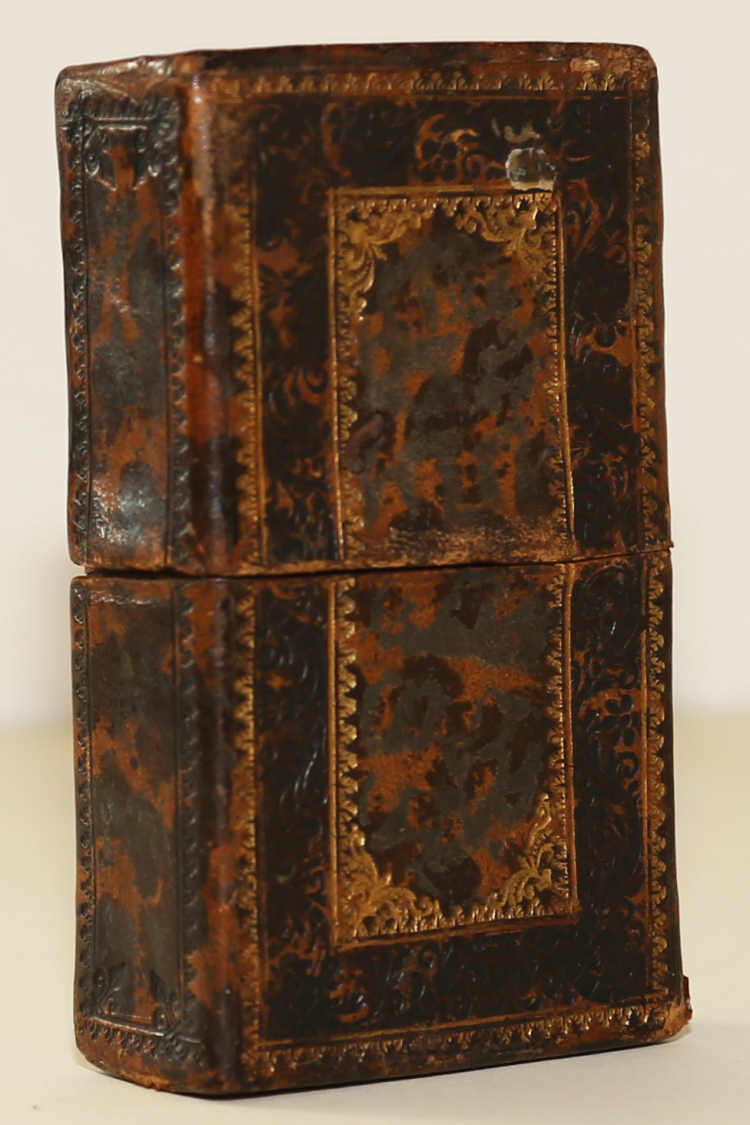













| Reference: | S0067 |
| Author | Antonio Visentini |
| Year: | 1748 ca. |
| Measures: | 60 x 110 mm |












| Reference: | S0067 |
| Author | Antonio Visentini |
| Year: | 1748 ca. |
| Measures: | 60 x 110 mm |
Antonio Visentini (1688 - 1782) after Francesco Zuccarelli (1702-1788)
Etchings (100x155 mm), 1748, signed on the 47th card, the castle on the elephant's back is printed "F.Z.I. 1748. AVisentini Sculp.".
Backs marbled, edges gilt, with the original leather case.
Set of 52 biblical playing cards, in four suits: circles, diamonds, hearts, and vases. Each card illustrates an episode from the Old Testament and bears within the suit sign an emblem whose significance is explained in the text below the illustration. The texts are given in Italian and in Latin. The cards are not numbered but each is lettered with capital or lower-case letters.
The etchings are by Antonio Visentini, after Francesco Zuccarelli (the 'Y' of vases is inscribed: "F.Z. I. 1748. AVisentini sculp.").
Under the auspices of Consul Smith, during the mid–1740s he produced with Visentini a series featuring neo-Palladian architecture, as can be seen in Burlington House (1746). The most interesting of the Zuccarelli and Visentini collaborations was this set of 52 playing cards with Old Testament subjects published in Venice in 1748. The hand-colored scenes are treated in a light manner; the suits are circles, diamonds, hearts, and jars, each containing a mixture of inscribed emblems; and the cards begin with the creation of Adam and end with a battle scene that has an elephant carrying a castle.
The British Museum copy is printed in red, backs marbled, edges gilt, with the original leather case.The British Museum also own 2 uncut sheets of the set, with the title, printed in black.
Both sets are from the collection of Lady Charlotte Schreiber.
In the British Art Center copy (Yale University), each suit is printed in a different color: circles (red), diamonds (blue), hearts (brown), and vases (green). Lacks one card (the 'n' of hearts). Includes contemporary slip-case of blind-stamped leather.
Bibliography:
Hargrave, C.P. History of playing cards and bibliography of cards and gaming, p. 237, 242; Schreiber, C. Playing cards of various ages and countries, III, 143; Franks, A W (introduction), Playing Cards of Various Ages and Countries selected from the collection of Lady Charlotte Schreiber, London, John Murray, 1895.
https://www.britishmuseum.org/research/search_the_collection_database/term_details.aspx?bibId=5438
|
Antonio Visentini (21 November 1688 – 26 June 1782) was an Italian architectural designer, painter and engraver, known for his architectural fantasies and capricci, the author of treatises on perspective and a professor at the Venetian Academy. Born in Venice, Visentini was a pupil of the widely travelled Baroque painter Giovanni Antonio Pellegrini,[1] who had painted some decors in English country houses at the beginning of the 18th century. Visentini is best known today as the engraver for Canaletto's first great series of Venetian vedute published under the title Urbis Venetiarum Prospectus Celebriores ex Antonii Canal,[2] organised by British resident Joseph (Consul) Smith (1682–1770). The series was begun around 1728 and by the time it was completed in 1735, thirty-eight etchings and engravings had been printed.
On the Grand Canal, Visentini was commissioned to redesign the façade of the residence of Consul Smith, the Palazzo Balbi. He collaborated with Francesco Zuccarelli on capriccios based on English Palladian villas, again for Consul Smith;[3] some have passed with Smith's collection to the British Royal Collection. In Vicenza, Visentini painted frescoes at the Villa Valmarana, for which Gian Domenico Tiepolo painted the figures. In the 1760s the English architect James Wyatt studied with him as an architectural draughtsman and painter.
Visentini's work, the Osservazioni,[4] published in Venice in 1771, was intended as a complement and an extension of a treatise by Teofilo Gallacini (1564–1641), which concerned itself with the errors of Mannerist and early Baroque architecture.[5] Visentini's engravings in the Osservazioni illustrate his proposed modifications correcting Baroque architectural details.
Visentini taught at the Accademia di Belle Arti in Venice from 1772–78, and he died in Venice in 1782.
|
|
Antonio Visentini (21 November 1688 – 26 June 1782) was an Italian architectural designer, painter and engraver, known for his architectural fantasies and capricci, the author of treatises on perspective and a professor at the Venetian Academy. Born in Venice, Visentini was a pupil of the widely travelled Baroque painter Giovanni Antonio Pellegrini,[1] who had painted some decors in English country houses at the beginning of the 18th century. Visentini is best known today as the engraver for Canaletto's first great series of Venetian vedute published under the title Urbis Venetiarum Prospectus Celebriores ex Antonii Canal,[2] organised by British resident Joseph (Consul) Smith (1682–1770). The series was begun around 1728 and by the time it was completed in 1735, thirty-eight etchings and engravings had been printed.
On the Grand Canal, Visentini was commissioned to redesign the façade of the residence of Consul Smith, the Palazzo Balbi. He collaborated with Francesco Zuccarelli on capriccios based on English Palladian villas, again for Consul Smith;[3] some have passed with Smith's collection to the British Royal Collection. In Vicenza, Visentini painted frescoes at the Villa Valmarana, for which Gian Domenico Tiepolo painted the figures. In the 1760s the English architect James Wyatt studied with him as an architectural draughtsman and painter.
Visentini's work, the Osservazioni,[4] published in Venice in 1771, was intended as a complement and an extension of a treatise by Teofilo Gallacini (1564–1641), which concerned itself with the errors of Mannerist and early Baroque architecture.[5] Visentini's engravings in the Osservazioni illustrate his proposed modifications correcting Baroque architectural details.
Visentini taught at the Accademia di Belle Arti in Venice from 1772–78, and he died in Venice in 1782.
|